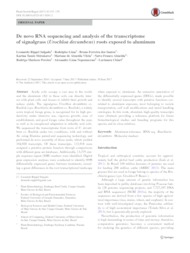De novo RNA sequencing and analysis of the transcriptome of signalgrass (Urochloa decumbens) roots exposed to aluminum.
De novo RNA sequencing and analysis of the transcriptome of signalgrass (Urochloa decumbens) roots exposed to aluminum.
Author(s): SALGADO, L. R.; LIMA, R.; SANTOS, B. F. dos; SHIRAKAWA, K. T.; VILELA, M. de M.; ALMEIDA, N. F.; PEREIRA, R. M.; NEPOMUCENO, A. L.; CHIARI, L.
Summary: Acidic soils occupy a vast area in the world, and the aluminum (Al) in these soils can directly interact with plant cells and tissues to inhibit their growth and reduce yields. The signalgrass Urochloa decumbens cv. Basilisk (syn. Brachiaria decumbens cv. Basilisk), a widely sown tropical forage grass, is recognized for its high productivity under intensive use, vigorous growth, ease of establishment, and good forage value throughout the year, as well as its exceptional adaptation to infertile acid soils. We sequenced the transcriptome from roots of U. decumbens cv. Basilisk under two conditions, with and without Al, using Illumina paired-end sequencing technology and performed de novo assembly of those reads, which yielded 164,920 transcripts. Of these transcripts, 113,918 were assigned a putative protein function through comparisons with different gene set databases. Additionally, 13,375 simple sequence repeat (SSR) markers were identified. Digital gene expression analyses were conducted to identify 6698 differentially expressed genes between treatments, revealing a great differences in the root transcriptional landscape when exposed to aluminum. An extensive annotation of the differentially expressed genes (DEGs), made possible to identify several transcripts with putative functions correlated to aluminum exposure, most belonging to vesicle transportation, cell wall modifications and metal handling ontologies. In this work, abundant, high-quality transcripts were obtained, providing a reference platform for future biotechnological studies and breeding programs for this species and its close relatives.
Publication year: 2017
Types of publication: Journal article
Unit: Embrapa Beef Cattle
Observation
Some of Embrapa's publications are published as ePub files. To read them, use or download one of the following free software options to your computer or mobile device. Android: Google Play Books; IOS: iBooks; Windows and Linux: Calibre.
Access other publications
Access the Agricultural Research Database (BDPA) to consult Embrapa's full library collection and records.
Visit Embrapa Bookstore to purchase books and other publications sold by Embrapa.

